Menus
- If it’s quick
- Completely sheltered from the wind on the BMW R 100 RS
- From 3500 rpm, the Boxer delivers full thrust
- BMW R 100 RS is stubborn and almost imperturbable
- Pure driving experience with the Moto Guzzi 850 Le Mans
- Cultivated and smooth
- A lot of power, mediocre chassis?
- From 6000 rpm the Kawasaki Z 900 gets serious
- BMW R 100 RS
- Data (type R 100 RS)
- technology
- Purchase check
- market
- Specialists
- history
- Moto Guzzi 850 Le Mans
- Data (Le Mans type)
- technology
- Purchase check
- market
- Specialists
- history
- Kawasaki Z 900
- Data (type Z 900A4)
- technology
- Purchase check
- market
- Specialists
- history
- Opinions
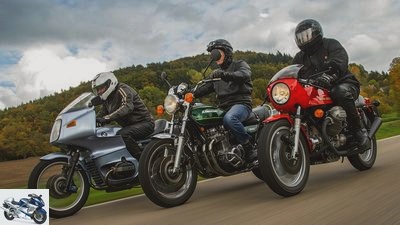
Rivas
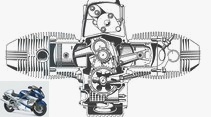

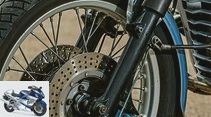
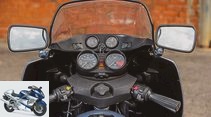
39 photos
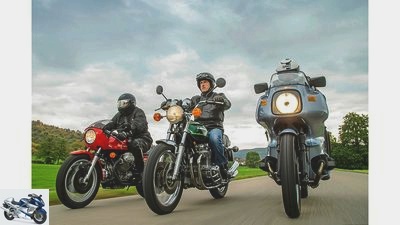
Arturo Rivas
1/39
The old controversial question of what makes really fast has moved bikers for generations: high performance, good aerodynamics or brilliant chassis? Using three fast bikes from 1976, we check which concept really scored 40 years ago.
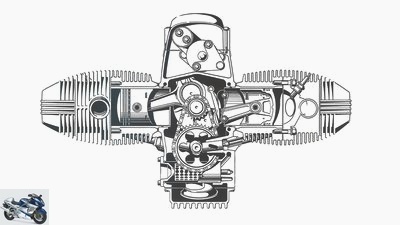
2/39
The boxer engine still shines with its simple design and ease of maintenance, but the one-liter version with a full 94 millimeter bore reaches its limits.
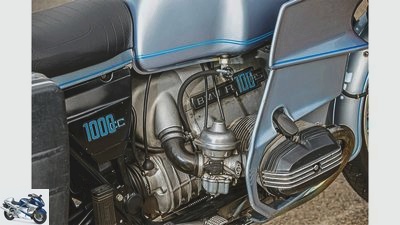
Arturo Rivas
3/39
Engine: Air-cooled two-cylinder four-stroke boxer engine, an underneath camshaft, two valves per cylinder, operated via rocker arms, displacement 980 cm³, output 51 kW (70 hp) at 7250 rpm.

Arturo Rivas
4/39
Double disc brakes with perforated 260-millimeter discs and ATE calipers: the better Brembo system didn’t come until 1981.
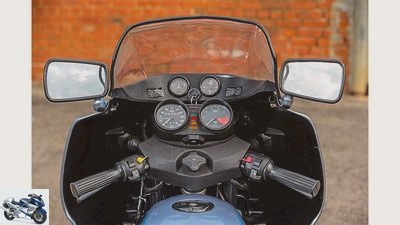
Arturo Rivas
5/39
RS command post: narrow handlebar stubs, lush cockpit with voltmeter and timer, tight-fitting, cheap-looking mirrors.
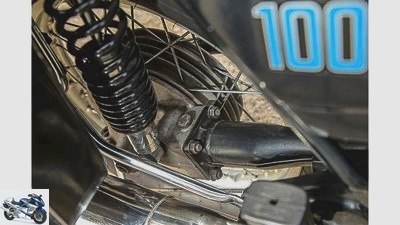
Arturo Rivas
6/39
The BMW cardan also ensures the well-known elevator effect in the R 100 RS when accelerating or releasing.
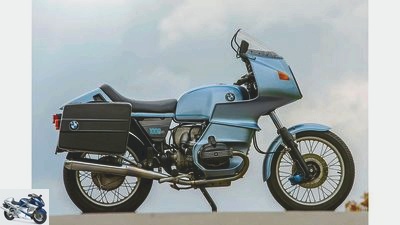
Arturo Rivas
7/39
BMW R 100 RS.
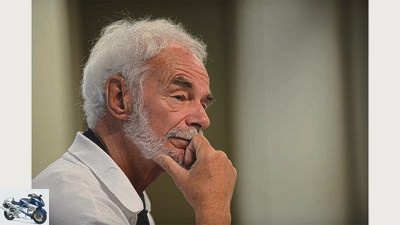
Sdun
8/39
BMW designer Hans A. Muth is considered the father of the RS concept.
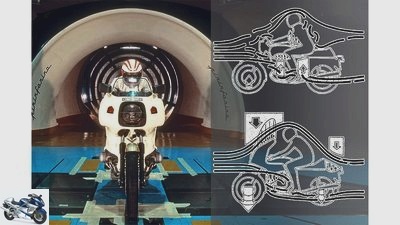
9/39
The RS fairing was tested and optimized in the wind tunnel of the Italian design company Pininfarina (Alfa, Ferrari, and many more). The RS shell offered more downforce, better wind protection and fewer vortices.
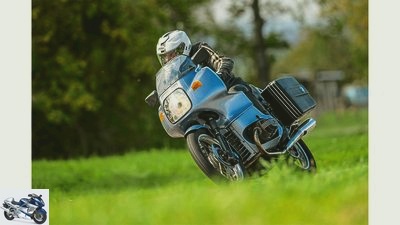
Arturo Rivas
10/39
BMW R 100 RS.
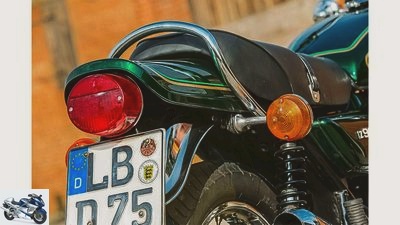
Arturo Rivas
11/39
The typical duck tail and the oval taillight run through as stylistic devices from the first Z1 to the successor Z 1000.
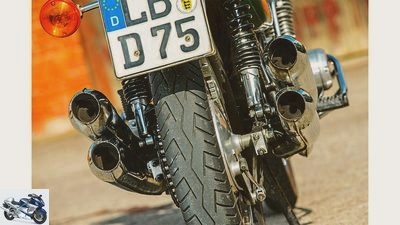
Arturo Rivas
12/39
The striking rear view of the Z 900 is still characterized by the four (now more muffled sounding) tailpipes.
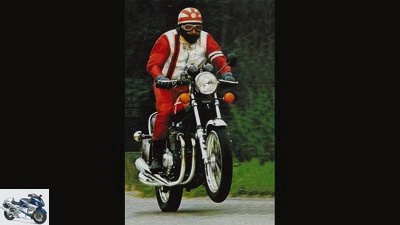
13/39
… for the Z1.
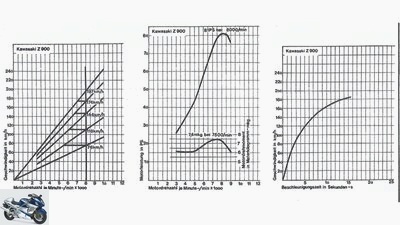
14/39
If you pull hard on the cable of the super powerful 900, you will make the rear tire smoke or the front wheel climb. That was already true …
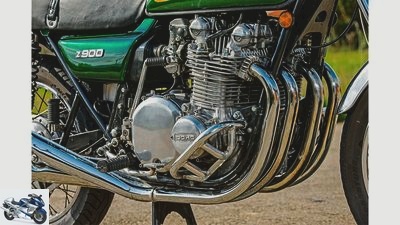
Arturo Rivas
15/39
Kawasaki Z 900. Fast through performance.
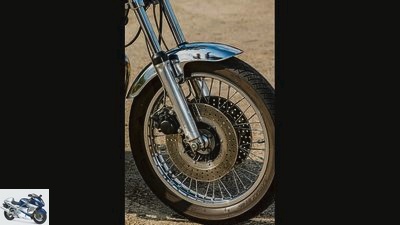
Arturo Rivas
16/39
What is safe is allowed: The subsequently perforated double disc now brakes more reliably even in wet conditions.
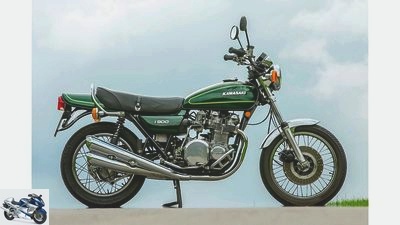
Arturo Rivas
17/39
Kawasaki Z 900.
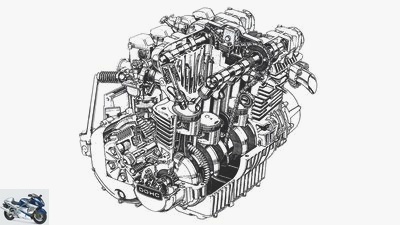
18/39
The four-cylinder with two overhead camshafts is easy to turn, strong, even durable and a real feast for the eyes.

Arturo Rivas
19/39
1972: The Kawasaki 900 Z1 caused a sensation with its 79 hp four-cylinder and four-in-four exhaust system – and that at an affordable price of 7200 marks.
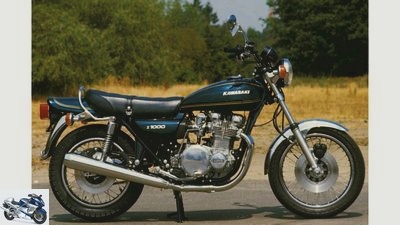
Arturo Rivas
20/39
1977: By enlarging the bore by four millimeters, the displacement increases to 1015 cm³, the power to 85 hp. At the rear, a disc brake releases the drum brake.
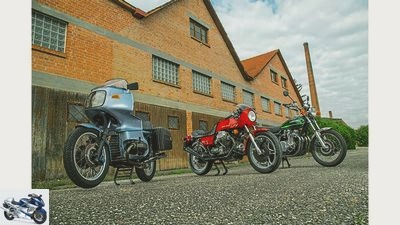
Arturo Rivas
21/39
And what do the respective owners say about their bikes?
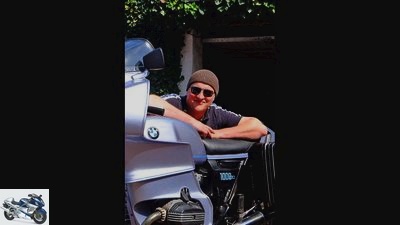
Arturo Rivas
22/39
Georg Godde, owner of the BMW R 100 RS:
I bought the RS in 2010 near Saarbrucken, an only slightly patinated, largely original and well-maintained machine from the first year of construction 76/77. The wind protection is perfect, and as a long-distance tourer with great potential for driving fun on country roads, it is still a great motorcycle today with completely sufficient power and decent torque from 2000 rpm. For me, the design is a milestone in motorcycle design and has not lost any of its elegant radiance to this day.

Arturo Rivas
23/39
Gunter Deisenhofer, owner of the Kawasaki Z 900:
For me, the Z 900 is still one of the most beautiful classic motorcycles, especially in the green paintwork of the 1976 model. The appearance and sound of the four-in-four system are also exhilarating. I enjoy going to club meetings with her or going on trips for two – the Z is good for every day, even for long vacation trips with luggage. In addition, it has never let me down and, with its 78,000 kilometers now, does not use any oil. My verdict can only be: beautiful, fast and reliable.
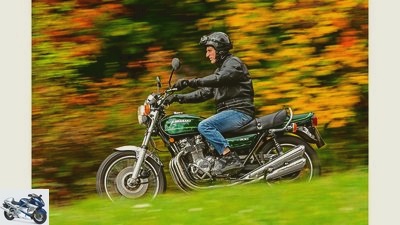
Arturo Rivas
24/39
Kawasaki Z 900.
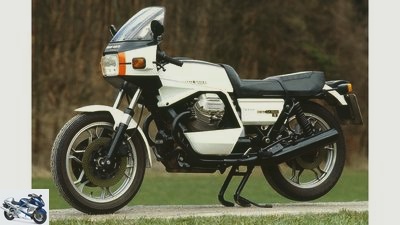
25/39
1978: The successor with the two-part fairing, in which the top part swiveled, was not very popular. At least 7,476 copies were built.
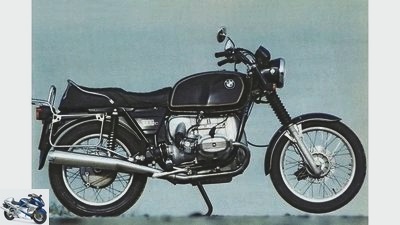
26/39
1976: The R 100/7 represents the 60 HP, ten HP weaker, but 15 kilograms lighter, basic version of the new Thousand series. Entry price at that time: 8,590 marks.
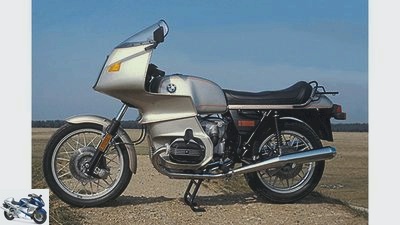
27/39
1978: The cast wheels previously offered as an option are now standard, instead of drums, there is now a rear disc brake and, if desired, a double bench seat (no extra charge).
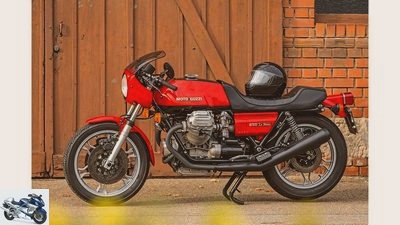
Arturo Rivas
28/39
Moto Guzzi 850 Le Mans.
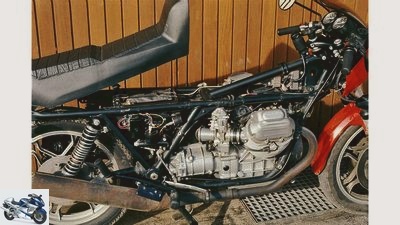
29/39
It can be so simple: consisting primarily of triangular braces, the Tonti frame guarantees maximum stability.
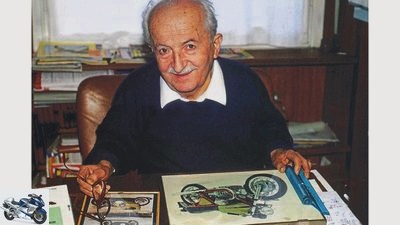
Motociclismo Italia
30/39
The ingenious Moto Guzzi designer Lino Tonti.
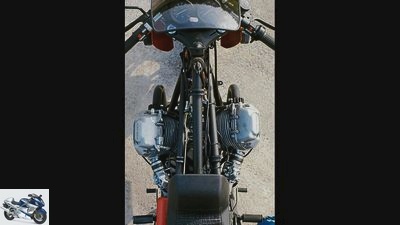
31/39
The sturdy frame made of round tubes encloses the mighty V2 engine in a slim and close-fitting manner.

Arturo Rivas
32/39
The finest: filigree cast wheels, integral brakes with Brembo saddles, wonderfully sounding Lafranconi exhaust bags.
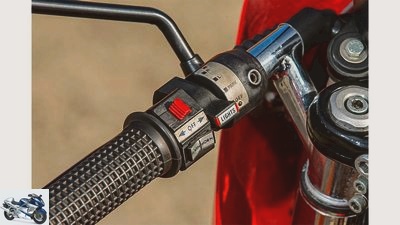
Arturo Rivas
33/39
For delicate fingers only: tiny handlebar switch unit. Hardly available as an original part and has long been sinfully expensive.
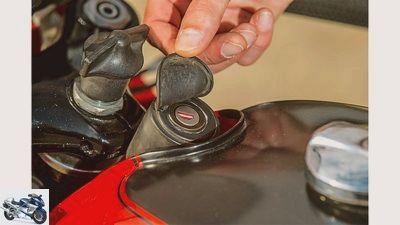
Arturo Rivas
34/39
The steering damper must sit there (left), the ignition lock in front of it not. At least with a protective cover…
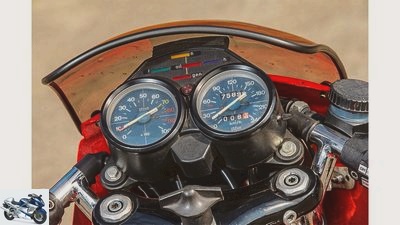
Arturo Rivas
35/39
Moto Guzzi 850 Le Mans.
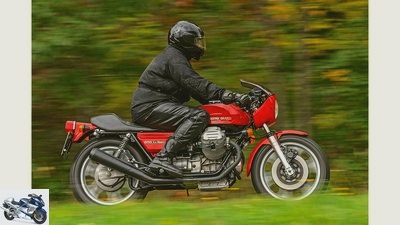
Arturo Rivas
36/39
Moto Guzzi 850 Le Mans.
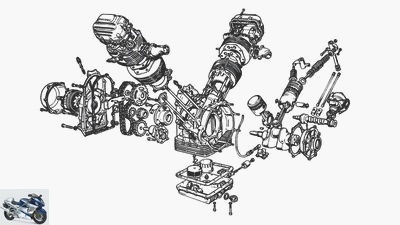
37/39
The basic concept of the logically structured, rock-solid V2 is retained across many models.
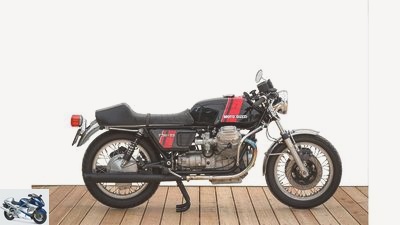
Alex Schelbert
38/39
1975: The 750 S3 already offered Le Mans technology such as Tonti frames and integral brakes. Only 998 pieces were built, which makes the beautiful predecessor a coveted rarity.
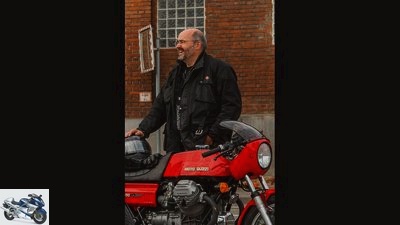
Arturo Rivas
39/39
Frank Schleicher, owner of the Moto Guzzi Le Mans:
The name already implies a touch of the racetrack.
But also from endurance (in the sense of the 24-hour race). And that’s pretty much the character of this motorcycle: this Guzzi is a fast, long-distance motorcycle. There it can bring its stable chassis, the pressure at medium speeds and the very pleasant integral brake to full advantage. And that with a high level of reliability and durability. Combined with stunning optics and acoustics, the best basis for a long love affair.
On the move with the BMW R 100 RS, Kawasaki Z 900 and Moto Guzzi 850 Le Mans
If it’s quick
Content of
The old controversial question of what makes really fast has moved bikers for generations: high performance, good aerodynamics or brilliant chassis? Using three fast bikes from 1976, we check which concept really scored 40 years ago.
W.hat has not existed since the dawn of motorization for discussions and disputes about the fundamental question of who is faster with which concept and is able to show the other the taillight. Countless round table debates may have led to such overheated minds that even a plentiful supply of drinks could hardly provide the necessary cooling. The question is on the one hand just as idle as it is highly interesting.
Buy complete article
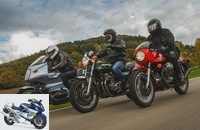
On the move with the BMW R 100 RS, Kawasaki Z 900 and Moto Guzzi 850 Le Mans
If it’s quick
The R 100 RS represented the man / machine philosophy, a contribution from BMW as a counterpart to the Far Eastern topic with a focus on power, technology, styling and low price, ”said Muth about the RS claim.
Completely sheltered from the wind on the BMW R 100 RS
It was important to “integrate the pilot into the machine”. Tests in the wind tunnel at Pininfarina in Italy yielded important values and findings, whereby the focus was not on the absolute minimization of air resistance (as with a racing motorcycle), but on the rider’s wind and weather protection, which is helpful in covering long distances very quickly and without fatigue. This is also shown by the comparison of the drag coefficient (drag coefficient) that is widely cited, especially in the automotive sector. This is 0.61 when the driver is seated and 0.59 when the driver is lying down. Which shows that the driver disappears almost perfectly behind the fairing, that is, a normal grown man sits in the saddle of the BMW R 100 RS practically completely protected from the wind.
MOTORRAD once verified and proven that this fact does not necessarily ensure the ultimate top speed by taking measurements with the full fairing removed. Because the fairing protects quite well, but offers a large frontal area, the values determined for the top speed are sobering. Top speed with / without fairing sitting: 189.5 / 193.5 km / h or lying 193.5 / 207 km / h. Not to be forgotten, however, is the effect of the integrated spoiler, which is supposed to guarantee more contact pressure on the road at high speeds and thus better straight-line stability.
From 3500 rpm, the Boxer delivers full thrust
At the presentation of the new BMW models at the IFMA in Cologne in 1976, the appearance of the BMW R 100 RS caused a sensation. There was soon such great demand for the 70 hp top model that customers had to endure delivery times of three months. The new thousand-generation boxer can now have a proud 94 (R 90: 90) millimeter bore and thus comes to a whopping 980 cm³ displacement. Stately 40s Bing carburettors and the increased compression from 9 to 9.5: 1 increase the performance of the two noble models R 100 S and R 100 RS to 65 and 70 hp respectively. Whereby the boxer of the RS is expected to do 7250 revs. Minimal modifications to the air filter hood and enlarged manifold cross-sections allow him to inhale and exhale better. Improvements to the gearbox, which up to now had to be shifted with a loud crack, should ensure more peace and quiet, various reinforcements and stiffeners on the frame for more driving stability. The steering damper fitted as standard on the BMW R 100 RS is intended to help prevent the handlebar from slapping.
The exit will show whether this all makes sense and, above all, quickly. Open both petrol taps, operate the stiff choke, press the starter button – the boxer shakes itself to life with heavy smacking noises, wants to be kept alive with thrusts of gas despite the choke being fully pulled. The 230 kilograms with a full tank are de facto a good figure, but feel like more when maneuvering. Let’s see how it goes. The BMW R 100 RS from Georg Godde has the original hump single seat bench (the double seat bench of the 100 S was optional). The handlebars are not placed too low, the footrests, which is immediately noticeable, are positioned far forward and not very sporty – the sitting posture looks strange. The boxer does not need much gas, hardly shakes and can, if necessary, accelerate carefully from 2000 rpm when strolling. Gas ripping goes from 2500 to 3000 rpm, at the latest from 3500 rpm the boxer also delivers the expected full thrust of a one-liter two-cylinder. In the range around 5000 rpm, slight vibrations can be felt in the hands and feet, but not annoying, but can be clearly read from the distorted images in the rear-view mirrors.
BMW R 100 RS is stubborn and almost imperturbable
The elderly boxer should now be spared the need to try out the speed limit. It doesn’t have to be, anyone who moves between 3500 and 6500 tours is always on the move quickly. Gear changes should, however, still be carried out carefully, and the gear stages should be selected with time and care. Especially when downshifting from third to second, a little double-declutching seems advisable. The BMW R 100 RS is not suitable for candidates who measure switching times in tenths of a second. The RS barely exhibits the notorious crash of the gearbox, even if all the noises from the engine, gearbox and cardan seem to be amplified by the resonance chamber represented by the large fairing. This is hardly drowned out by the head wind, which is simply hardly heard or felt. Admittedly, the forehead section of the helmet protrudes a little over the edge of the fairing, but does not cause any turbulence or roaring noises. So you could actually endure hours of highway jets and achieve high travel cuts, also thanks to the large 24-liter tank.
The stabilizing effect of the fairing spoiler is already noticeable at 150 km / h – the BMW R 100 RS is actually stubborn and almost imperturbable. Even willfully initiated shakiness is ignored by the RS almost sullenly. However, she is unwilling to take on fast alternating curves, although the narrow tires would actually offer the best conditions here. The narrow, heavily cranked handlebars offer little leverage, the knees trapped between the fairing shell and the tank create a somewhat uncomfortable, cramped driving experience. It goes without saying that the cardan comes up with its well-known elevator effect, which you have to get used to and adapt to your driving style. Even the brakes, which were once vaunted, present themselves at best as acceptable stoppers from today’s perspective. They require hand strength, look a bit dull, but slow down quite effectively. No less, but no more. What remains is the driving impression that BMW had in mind when they called the RS a travel sports motorcycle – with an emphasis on travel. The R 100 top model is fascinating in its own way, the boxer delivers more tasty than ever, and behind the full shell you sit almost as well protected as in the car.
Pure driving experience with the Moto Guzzi 850 Le Mans
That doesn’t apply at all to the Moto Guzzi 850 Le Mans, which holds the chassis flag high on this lap. With its racing genes, it stands for pure driving experience, without frills or concern for comfort. Light and stable at the same time. Does the equation work? Of course, this does not work entirely without motor skills. With 70 hp, Le Mans plays well in the 1976 league, but does not set any top figures. But unlike some more powerful bikes, the power can always be brought to the road, converted into a brisk riding style and thus able to stand up to the competition. At least that is the plan of the Italians.
The racing activities of the company from Mandello del Lario created the prerequisites for fast production vehicles with stable chassis at an early stage. At the latest with the arrival of the ingenious designer Lino Tonti, the direct history of the creation of the Moto Guzzi 850 Le Mans begins. Tonti began to work on the engines in 1969, and this was how victorious racing motorcycles were to be created. He also developed the 757 cm³ engine of the V7 Special, the forerunner from which the 844 cm³ engine of the Le Mans was later to emerge by increasing the stroke. However, the Italian has become better known through the development of the legendary frame, which was first installed in the V7 Special. He constructed this very closely around the V2, mounted the alternator on the front crankshaft stub to save overall height and lower the center of gravity. For better dismantling, Tonti designed the left beam to be removable. The construction, made of thick round tubes, predominantly welded together in triangular formations, proved to be incredibly stable.
At the Bol d’Or in Le Mans in 1972, the V7 started with the 850 engine and, following transmission problems, set one fastest lap after the other in a wild race to catch up. In the ecstasy of joy after the end of the race, it was decided to call the 850 Le Mans in future. The production version was presented in November 1975 and went into production in spring 1976. Contrary to some statements to the contrary, a total of 6200 copies rolled off the production line (first series 1975/1976: frame numbers VE 11111 to VE 13040, second series 1977/1978: VE 13041 to VE 17311).
Cultivated and smooth
Our photo bike comes from the first series and belongs to Frank Schleicher, a Guzzi fan through and through. He owns 53 Guzzis in total, he bought the Moto Guzzi 850 Le Mans in 2002 and restored it to its original condition from its modified condition (full fairing, sports footrests, etc.). He didn’t do anything on the engine apart from an inspection, an overhaul was and is not necessary today. After the characteristic start-up procedure, it loudly announces how healthy the V2 is: the two 36 mm Dellorto carburettors have to be flooded with a swab, two short turns of the throttle activate the accelerator pumps, and at the push of a button the powerful starter throws itself into the stuff thick V2 in motion. To speak of the powerful roar of the engine would be an understatement – the sound gives every two-wheeler fan goose bumps. Sure, the Lafranconi pots are installed “and registered”, says Frank. By the way, when they were bought, they had to be repaired by the meticulous development engineer. There is no need for a long warm-up phase, it is best to apply a few thrusts of gas until the engine has a stable idle, then drive off slowly and warm up carefully.
High revs are not necessary anyway, the Moto Guzzi 850 Le Mans starts to move in an astonishingly cultivated and jerk-free manner, runs smoothly from 2000 rpm and accelerates cleanly. Up to 4000 rpm it is already moving well enough to swim with in everyday operation, but from 4000 to 4500 rpm the V2 then pushes powerfully, if necessary up to over 7000 rpm. The gear changes require a determined step, but work dry and precise. Long shift breaks are not necessary, and thanks to the large centrifugal mass, you can take the excess speed with you and enjoy the rubber-like catapult effect after the clutch is engaged. Splendid. To avoid the reverse effect of the high braking torque when downshifting, a little double-declutching helps, also to allow the gear to engage more cleanly. However, thanks to the wide rev range that can be used, there is no need to shift gears all too often, which is why the driver can concentrate entirely on the clean line selection, which the Guzzi never questioned. The chosen line is always followed neatly, even at high speeds there is no wobbling, no restlessness, simply impeccable driving stability. Or as Frank puts it a little exaggerated: “You can step to the handlebars at full speed – nothing wobbles”. Right.
And his words of praise for the integral brake – by the way, the Moto Guzzi 850 Le Mans is the first production motorcycle with such a system – can be understood by anyone who has dived into it. The rear brake and the left front brake calliper are actuated at the same time using the foot pedal, which results in a good brake balance and impressive overall deceleration. A pleasant side effect: the driver has his right hand completely free for exhausting double-declutching on the stiff throttle grip before downshifting. The fact that you sit on the motorcycle rather than in the motorcycle (but by no means uncoupled) and enjoy little comfort overall, but rather crouch over the narrow handlebars, is hardly noticeable, let alone it bothers you while driving. Anyone who controls Le Mans is completely in driving mode, focused on the machine and the line, and becomes one with the vehicle. When it comes down to it, the Guzzi more than makes up for a few missing horsepower with its chassis. At any time.
A lot of power, mediocre chassis?
A lot of power, mediocre chassis? That sounds like the allegations that the Kawasaki Z1 was exposed to from the start when it was presented in 1972 and unsettled the first test drivers. The four-cylinder engine had an abundance of 79 hp, but drove the sweat on the forehead of many a hot spur with a sometimes wildly moving chassis. She was quick from the start, in the sprint from zero to hundred and at top speed. But not everyone dared to try the latter. That was to change with the revised 900, which was henceforth called the Kawasaki Z 900, from 1976. Kawa added a little more power and raised it to 81 hp, but above all the chassis underwent important modifications. A few changes to the air filter box and intake as well as other carburetors (previously 28, now 26 Mikunis) were sufficient for the engine. Frame tubes with an increased wall thickness from 1.8 to 2.3 mm should provide more stability.
It remains to be seen whether these measures will be sufficient to drive out the earlier notorious buildup of the 900. What is certain is that the Kawasaki Z 900 is still not a lightweight at 256 kilos. How is this noticeable when driving? Let’s see.
From 6000 rpm the Kawasaki Z 900 gets serious
Gunter Deisenhofer, owner of our photo bike, gives me his Kawasaki Z 900. He bought it in 2007, at that time still in its original brown and moderate condition, had it technically checked and made ready to drive and repainted in the likewise original green. Since then, the chemical engineer has covered almost 30,000 kilometers without any problems. The already warm four-cylinder starts at the push of a button, its subtle rumble looks familiar and always inspires. It sounds a bit more subdued than the Z1 growl, but when Frankenstein’s daughter, as MOTORRAD colleague Schermer called her in the first test, is let off the chain, she should already show where the Z-hammer is hanging. And no matter how much it initially gives the harmless everyday bike to stroll around, revs up evenly and without jerks – when the speed reaches the 6000 zone, the Kawa gets serious. It revs up in a flash, the 8000 mark of maximum power scurries by and you have your hands full, shifting gears at 9000 rpm at the latest and turning off the gas if possible in order to put a stop to the angry propulsion. A moment ago you were sitting relaxed and upright behind the high, wide handlebars, the next moment the fury woke to life. The Kawasaki Z 900 can do both – a lamb-pious everyday bike to get a sandwich and a wild sprint monster.
It is undoubtedly fast, but it needs speeds. And at least here and now it does not reveal any rocking or wobbling. The fork does its job a bit dry, almost stony, the original struts at the rear have long since made room for Konis, which have been proven to work well. In view of its high weight, the Kawasaki Z 900 even falls nimbly on an incline and is easy to steer – a bike for all walks of life, even for a vacation for two, says Gunter. But if you wanted to go out and take on the BMW R 100 RS and Moto Guzzi 850 Le Mans, the Kawa lacked the last precision and the last effort, even the rather dull-looking double pane would have to accept criticism and the support of the Secure rear drum brake that decelerates surprisingly well. To realize the full performance of the Kawa, you still need a courageous driver. Because as it once said in a test report: “The Z 900 in particular makes people aware of the fact that motorcycling is a matter of character.” Then the regulars’ tables agree again.
BMW R 100 RS
Arturo Rivas
BMW R 100 RS – Fast thanks to aerodynamics.
archive
The RS fairing was tested and optimized in the wind tunnel of the Italian design company Pininfarina (Alfa, Ferrari, and many more). The RS shell offered more downforce, better wind protection and fewer vortices.
The BMW R 100 RS claims to be the first motorcycle with standard, frame-fixed full fairing. The multi-part plastic shell weighing just 9.5 kilograms was developed and optimized in the wind tunnel of the famous Pininfarina design company in Turin. The then BMW styling boss Hans A. Muth originally did not have the minimization of the air resistance in mind, but the optimization of the human / machine unit. And thus the focus on maximum comfort for the driver. Integrated spoilers are designed to increase downforce and thus improve stability at high speeds. The drag coefficient (drag coefficient) is almost identical with the driver sitting (0.61) and lying down (0.59), which is why the top speeds (189.5 and 193.5 km / h) are hardly different. The large face of the fairing prevents better values, but the BMW enables fatigue-free high travel cuts on long journeys.
Data (type R 100 RS)
Arturo Rivas
Boxer of the BMW R 100 RS.
Engine:
Air-cooled two-cylinder four-stroke boxer engine, an underneath camshaft, two valves per cylinder, operated via rocker arms, displacement 980 cm³, output 51 kW (70 PS) at 7250 rpm
Power transmission:
Single-disc dry clutch, five-speed gearbox, cardan drive
Landing gear:
Double loop frame made of tubular steel, telescopic fork at the front, Ø 36 mm, two-arm swing arm, two spring struts, wire-spoke wheels with light alloy rims, tires 3.25 H 19 at the front, 4.00 H 18 at the rear, double disc brake at the front, Ø 260 mm, single-piston swiveling caliper, drum brake at the rear, Ø 200 mm
Mass and weight:
Wheelbase 1465 mm, weight with a full tank of 230 kg
Driving performance:
Top speed 193 km / h
technology
archive
The boxer engine still shines with its simple design and ease of maintenance, but the one-liter version with a full 94 millimeter bore reaches its limits
The boxer engine, which is basically based on the engines of the / 5 models, with its unchanged stroke of 70.6 millimeters, was drilled out to a record 94 millimeters in order to make the liter capacity full. The crankshaft with plain bearings still has to do without a third, middle bearing. And because the valve train is still carried out via long bumpers and rocker arms, the maximum engine speeds are still limited. Higher compression (9.5 instead of 9.0: 1) and 40 instead of 32 Bing constant pressure carburettors ensure that the BMW R 100 RS has 70 HP, which is ten HP higher than the basic R 100/7. What all thousands have in common is the new crankcase ventilation system, which is supposed to reduce oil consumption. To improve handling, the frame of the R 100 series was stiffened. Larger gusset plates in the steering head area, a cross connection tube under the steering head and stronger gusset plates on the swing arm ensure more stability. The cast wheels, which were previously optional, were already available as standard from model year 1978, plus a rear disc brake instead of a drum brake.
The BMW R 100 RS was drastically revised for 1981: extended oil circuit, modified intake tract (plate air filter), modified rocker arms, stronger connecting rods, flywheel mass reduced by 30%, light metal cylinders with Nikasil coating and contactless transistor ignition. In addition, a Brembo fixed caliper brake replaced the ATE swivel caliper brake at the front.
Purchase check
The usual checkpoints for boxers apply to the BMW R 100 RS: Check the engine and drive for leaks. Oil mist is still okay, if it is already dripping, action needs to be taken. For example, if the shaft sealing ring is defective, recognizable by the drop from the ventilation slot between the motor and the gearbox. The rocker arms of the high-revving RS boxer, which in some cases initially tended to break, were reinforced from 7 to 11 mm from mid-1977 (chassis number: 6084533). You should also clarify whether boxers with high mileage have already been converted to unleaded petrol in the course of a possible overhaul (new valve seats). If the battery indicator light does not go out even at higher speeds, the vibrations of the alternator have probably put an end to it. If the RS is jacked up on both tires, the weak main stand has given way – a reinforced original part can help.
market
A proud 33,648 of the first series of the BMW R 100 RS were built between 1977 and 1984. The range of used vehicles is still relatively modest today, according to the KBA only 927 units are registered.
RS models with high mileage are available from around 3000 euros, good models with medium mileage are available from around 4500 euros, and top models cost between 5000 and 8000 euros.
Specialists
Siebenrock GmbH
Telephone 070 24/46 88-10,
www.siebenrock.com
WÜDO
Telephone 02 31/4 77 77 70,
www.wuedo.de
Clubs and forums
www.boxer-forum.de
www.2-ventiler.de
history
archive
BMW R 100/7
1976: The BMW R 100/7 is the 60 HP, ten HP weaker, but 15 kg lighter, basic version of the new Thousand series. Entry price at that time: 8,590 marks
archive
BMW R 100 RS 1978
1978: The cast wheels previously offered as an option are now standard, instead of drums, there is now a rear disc brake and, if desired, a double bench seat (no extra charge).
Moto Guzzi 850 Le Mans
Arturo Rivas
Moto Guzzi 850 Le Mans – fast chassis
Motociclismo Italia
The ingenious Moto Guzzi designer Lino Tonti
The highest performance is of no use if it cannot be implemented, cannot be brought onto the road. Last but not least, this wisdom must have been behind the efforts of the then Moto Guzzi chief designer Lino Tonti, who was also able to draw his experience from racing.
archive
It can be so simple: consisting primarily of triangular braces, the Tonti frame guarantees maximum stability
With the construction of the chassis, which is still famous today and known as the Tonti frame, he created the conditions for fast laps on and off the racetrack. This frame, mainly made of solid, round steel tubes in triangular formations, ensures the compact dimensions and the low center of gravity of the Guzzi bikes by enclosing the V2 tightly.
archive
The sturdy frame made of round tubing surrounds the mighty V2 engine of the Moto Guzzi 850 Le Mans in a slim and close-fitting manner.
And it enables the driver to fully utilize the engine’s performance. Low overall weight, maximum precision in fast corners and impeccable straight-line stability turn the apparently inferior Italo bikes into lightning-fast racers. The first specimens with Tonti frames were seen as early as 1971. In the form of the V7 Special. The legendary chassis was used in larger numbers for the first time in the Moto Guzzi 850 Le Mans. Incidentally, the ingenious designer Tonti died in June 2002.
Data (Le Mans type)
Arturo Rivas
Moto Guzzi 850 Le Mans
Engine:
Air-cooled two-cylinder four-stroke 90-degree V-engine, an underneath camshaft, two valves per cylinder, operated via bumpers and rocker arms, displacement 844 cm³, output 51 kW (70 hp) at 7000 rpm
Power transmission:
Two-disc dry clutch, five-speed gearbox, cardan drive
Landing gear:
Double loop frame made of tubular steel, telescopic fork at the front, Ø 35 mm, two-arm swing arm, two spring struts, cast light alloy wheels, tires 3.50 H 18 at the front, 4.00 H 18 at the rear, double disc brake at the front, Ø 300 mm, disc brake at the rear, Ø 242 mm, integral brake system
Mass and weight:
Wheelbase 1490 mm, weight with a full tank 225 kg
Driving performance:
Top speed 203 km / h
technology
archive
The basic concept of the logically structured, rock-solid V2 is retained across many models.
For use in the Moto Guzzi 850 Le Mans, the 757 cm³ engine, originally from the V7 Special from 1969, was brought to 844 cm³ by increasing the stroke from 70 to 78 millimeters (with 83 millimeters bore as before). Reinforcing ribs and thicker walls in the engine and cardan housings were necessary in order to be able to cope with the power that has now increased to 70 hp. The valve train with its lower, central camshaft, aluminum bumpers and forged, needle-bearing rocker arms remained almost unchanged. Changed valve timing as well as larger valves and ducts, however, ensured better filling and helped the V7 engines, which were once considered weak-chested below, to achieve a fuller torque curve. The earlier 30s had to give way to two 36 Dellorto carburettors with open intake funnels.
The frame, which has been used since the V7 Sport, with the ingenious construction of triangular braces and a practical, unscrewable left support, was also used in the Moto Guzzi 850 Le Mans, as was the integral brake known from the 750 S3, where the left saddle is operated using a foot pedal the front double disc and the rear disc brake are activated. The hand lever only acts on the front right saddle. The fork is also a technical highlight: closed damper cartridges work in the fork legs – the remaining fork oil is only used to lubricate the sliding tubes and the spring.
Purchase check
The good news first: Le Mans specimens that are always carefully warmed up do not cause any major problems, at least on the engine side, and are considered robust and durable. If you have the chance to check the compression: it should never be below seven bar. For everyone else: smoke from the exhaust indicates worn pistons / cylinders or worn valve stem seals. A slight clacking of the valve train, on the other hand, must not only be, but should be. Some owners mean it too well and set the game too tight, which literally provokes damage. The engine / gearbox and cardan should be checked for leaks; if it drips under the bell housing, the oil seals are due. Suspicious noises can be easily identified by engaging fifth gear while standing and paying attention to suspicious clicking or scraping noises when pushing back and forth. If something cracks from the drive during a sudden gas change during a test drive, the universal joint could be over. If you value the original condition, you should make sure that the handlebar switches, the seat and the small lamp cover (made of ABS – replicas often made of fiberglass) are difficult to find and very expensive. The conversion to Koni struts is popular and useful at the Moto Guzzi Le Mans.
market
If you are looking for a good, original Moto Guzzi Le Mans of the first series, you need patience (according to KBA approved: 483 vehicles) and should have a few thousand fluently. For less than 5000 euros, there are at most tinkered, mostly non-drivable construction sites. Ready-to-drive specimens in good condition are usually between 6000 and 10,000 euros, for top specimens around 15,000 euros are due.
Specialists
Moto Guzzi Baker GmbH
Telephone 025 54/6475,
www.motoguzzi-baecker.de
Stein-Dinse GmbH
Telephone 0531/12 33 00-0,
www.stein-dinse.com
history
Alex Schelbert
Moto Guzzi 750 S3
1975: The 750 S3 already offered Le Mans technology such as Tonti frames and integral brakes. Only 998 pieces were built, which makes the beautiful predecessor a coveted rarity.
archive
1978: The successor with the two-part fairing, in which the top part swiveled, was not very popular. At least 7,476 copies were built.
1978: The successor with the two-part cladding, in which the top part swiveled, was not very popular. At least 7,476 copies were built.
Kawasaki Z 900
Arturo Rivas
Kawasaki Z 900 – fast through performance.
When answering the question of what makes things fast, Kawasaki relies on the oldest and simplest recipe in 1976: sheer engine power should fix it. With 81 hp, the four-cylinder Kawasaki Z 900 offers two more hp than its legendary predecessor, the Z1, and the highest value among mass-production bikes at the time.
archive
If you pull hard on the cable of the powerful Kawasaki Z 900, the rear tire will smoke or the front wheel will climb.
The values for acceleration and top speed that were once measured in the test prove that the horses are completely gathered together and are well fed: the Kawasaki Z 900 can even sprint from 0 to 100 km / h with two people in an amazing 3.5 seconds. The fact that pure maximum performance can only be achieved at high speeds and at the expense of the lush torque in the lower and middle range is accepted here.
The Kawasaki Z 900 cannot offer the full thump of a one-liter two-cylinder, and those who constantly call up the high performance have to expect high fuel consumption of easily over ten liters / 100 kilometers.
Data (type Z 900A4)
Arturo Rivas
Kawasaki Z 900
Engine:
Air-cooled four-cylinder four-stroke in-line engine, two overhead camshafts, two valves per cylinder, actuated by bucket tappets, displacement 903 cm³, output 60 kW (81 PS) at 8000 / min, max. Torque 74 Nm at 7500 rpm
Power transmission:
Multi-disc oil bath clutch, five-speed gearbox, chain drive
Landing gear:
Double loop frame made of tubular steel, telescopic fork at the front, Ø 36 mm, two-arm swing arm, two spring struts, wire-spoke wheels, tires 3.25 H 19 at the front, 4.00 H 18 at the rear, double disc brake at the front, Ø 296 mm, single-piston floating caliper, simplex drum brake at the rear, Ø 200 mm
Mass and weight:
Wheelbase 1490 mm, weight with a full tank of 256 kg
Driving performance:
Top speed 217 km / h
technology
archive
The four-cylinder of the Kawasaki Z 900 with two overhead camshafts is easy to turn, strong, even durable and a real feast for the eyes.
The four-cylinder of the Kawasaki Z 900, which in its original form saw the light of day in the two-wheeled world as early as 1972 in the predecessor Z1, always delighted with revving and proud top performance with considerable stability at the same time.
The not entirely vibration-free engine with six-fold roller bearing crankshaft underwent various technical changes and an increase in output to 81 hp for the 1976 model year in the course of changing the model name to Z 900. The suction paths were modified and the suction nozzles were funnel-shaped in order to achieve a higher flow rate that promotes performance. The air filter element has been enlarged, but the carburetor aperture has been reduced. Now 26 (previously 28) Mikuni round slide carburettors are used. The damper inserts in the exhaust pipes also had to be changed in order to reduce noise. The changes to the chassis and brakes appeared to be even more important: At the front, an appropriate double disc system now decelerates, the wall thickness of the frame tubes grew from 1.8 to 2.3 millimeters. What remained are the weakly damped fork and the overstrained struts, which were mostly soon exchanged for Koni specimens. In view of the lousy light, it is also advisable to convert the headlight (40/45 watt) to H4 light.
Purchase check
Vibration was and is an issue with the Z models – so burned out lightbulbs are just as common as checking the electrical system as a whole is recommended. Cable harnesses that have become brittle, oxidized plug connections are not uncommon and should be examined carefully. Regulators and rectifiers can also cause problems; if this type of defect occurs, the battery will either not be charged or it will boil. The pretty but rust-prone four-in-four exhaust system should be examined carefully. Replacements are difficult to find and really expensive.
An engine overhaul is also expensive, so steer clear of specimens with engines that rumble dully when idling – the pressed crankshaft has to be laboriously and expensively dismantled. Blue smoke from the exhaust when overrun or when accelerating sharply indicates worn, leaky valve stems or worn piston rings. Oil consumption of up to one liter per 1000 kilometers is still acceptable.
market
The popularity of the Z models is unbroken and the demand is consistently high. The increase in value can therefore still be regarded as guaranteed. Kawasaki Z 900 copies (approved according to KBA: 527 pieces) in their original condition therefore (similar to the somewhat more popular Z1) usually cost at least 4,000 euros (ready to drive), over 7,000 euros (good condition) to well over 10,000 euros (top condition).
Specialists
Roland Loins
Telephone 0 61 71/5 54 11,
www.lenden.de
Z-Service Frank Bach
Telephone 0 65 71/14 83 70,
www.zclassicservice.de
Clubs and forums
www.z-club-germany.de
www.kawasaki-z-classiker.de
history
Arturo Rivas
Kawasaki 900 Z1
1972: The Kawasaki 900 Z1 caused a sensation with its 79 hp four-cylinder and four-in-four exhaust system – and at an affordable price of 7200 marks.
Arturo Rivas
1977: By enlarging the bore by four millimeters, the displacement increases to 1015 cm³, the power to 85 hp. At the rear, a disc brake releases the drum brake.
1977: By enlarging the bore by four millimeters, the displacement increases to 1015 cm³ and the power to 85 hp. At the rear, a disc brake releases the drum brake.
Opinions
Arturo Rivas
Different approaches, one goal: be fast. What do the owners think of their bikes?
Arturo Rivas
Georg Godde, owner of the BMW R 100 RS.
I bought the BMW R 100 RS near Saarbrucken in 2010, an only slightly patinated, largely original and well-maintained machine from the first year of construction 76/77. The wind protection is perfect, and as a long-distance tourer with great potential for driving fun on country roads, it is still a great motorcycle today with completely sufficient power and decent torque from 2000 rpm. For me, the design is a milestone in motorcycle design and has not lost any of its elegant radiance to this day.
Arturo Rivas
Frank Schleicher, owner of the Moto Guzzi Le Mans.
The name already implies a touch of the racetrack. But also from endurance (in the sense of the 24-hour race). And that pretty much matches the character of the Moto Guzzi 850 Le Mans: This Guzzi is a fast long-distance motorcycle. There it can bring its stable chassis, the pressure at medium speeds and the very pleasant integral brake to full advantage. And that with a high level of reliability and durability. Combined with stunning optics and acoustics, the best basis for a long love affair.
Arturo Rivas
Gunter Deisenhofer, owner of the Kawasaki Z 900.
For me, the Kawasaki Z 900 is still one of the most beautiful classic motorcycles, especially in the green paintwork of the 1976 model. The appearance and sound of the four-in-four system are also exhilarating. I enjoy going to club meetings with her or going on trips for two – the Z is good for every day, even for long vacation trips with luggage. In addition, it has never let me down and, with its 78,000 kilometers now, does not use any oil. My verdict can only be: beautiful, fast and reliable.
Related articles
-
Famous motorcycles: Moto Guzzi 850 Le Mans
Gori Famous motorcycles: Moto Guzzi 850 Le Mans When eagles still flew, eagle wings are majestically emblazoned in the Moto Guzzi logo. At the time of the 850 Le …
-
On the move: BMW R 100 S, Honda CB 900 F Bol d’Or, Moto Guzzi Le Mans I.
fact On the move: big bikes from the 70s BMW R 100 S, Honda CB 900 F Bol d’Or, Moto Guzzi Le Mans I. Content of At the turn of the decade, MOTORRAD…
-
On the move: Moto Guzzi California
Moto Guzzi On the move: Moto Guzzi California and California Vintage California Dreams Contents of In the 70s, the Beach Boys intoned a …
-
Top test Moto Guzzi Stelvio 1200 4V
Bilski 10 pictures Moto Guzzi 1/10 Moto Guzzi 2/10 Moto Guzzi 3/10 Moto Guzzi 4/10 Moto Guzzi 5/10 Moto Guzzi 6/10 Moto Guzzi 7/10 Moto Guzzi 8/10 Moto …
-
Moto Guzzi 850 Le Mans from 1976
Archive 19 pictures MPS photo studio 1/19 The new sporty spearhead from Moto Guzzi was, in view of the first test in MOTORRAD 24/1976, a …
-
On the move: Moto Guzzi V7 Cafe Classic
fact On the move with the Moto Guzzi V7 Cafe Classic Yellow-green, air-cooled and spartan Contents of The Guzzi-Adler has offspring. Yellow-green, air-cooled …
-
Siemer On the move: Moto Guzzi V7 steam announcement Contents of No teeth in the mouth, but La Paloma whistle: This is how it looked when Moto Guzzi despite the highest …
-
On the move with the Honda CB 900 F Bol d‘Or, Honda CBX, Kawasaki Z 1000 ST and Kawasaki Z 1300
Arturo Rivas 45 pictures Arturo Rivas 1/45 Six against four for first: Honda CBX and Honda CB 900 Bol d’Or. Arturo Rivas 2/45 Honda CBX. Arturo Rivas 3/45 …
-
Driving report Moto Guzzi Stelvio 1200 4V
Moto Guzzi Driving report Moto Guzzi Stelvio 1200 4V Alpine swingers Mighty, fateful: the Moto Guzzi Stelvio is as impressive as the Stelvio Pass, after…
-
Kawasaki ZXR 1100 versus Moto Guzzi V11 Sport
Kawasaki ZXR 1100 versus Moto Guzzi V11 Sport Japan versus Europe: Naked Bikes Motorcycles without filters: Naked Bikes, pure driving pleasure. Kawasaki ZXR 1100 against …